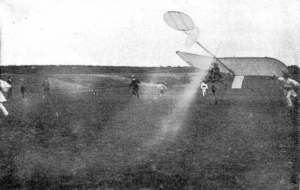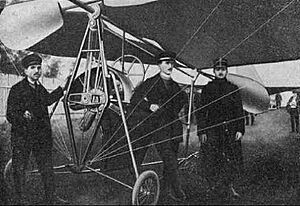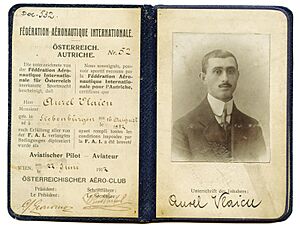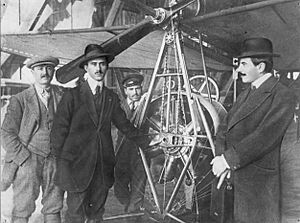Aurel Vlaicu facts for kids
Quick facts for kids
Aurel Vlaicu
|
|
|---|---|
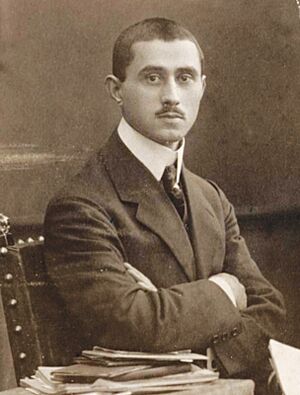 |
|
| Born |
Aurel Vlaicu
19 November 1882 Binținți, Austria-Hungary (now part of Geoagiu, Romania)
|
| Died | 13 September 1913 (aged 30) Bănești, Kingdom of Romania
|
| Cause of death | plane crash |
| Resting place | Bellu Cemetery, Bucharest |
| Nationality | Romanian |
| Alma mater | Budapest University of Technology and Economics Technische Universität München |
| Occupation | Engineer, inventor, aviator |
| Known for | Pioneer of Romanian and world aviation |
| Parent(s) | Dumitru Vlaicu (father) Ana (mother) |
| Awards |
|
Aurel Vlaicu (Romanian pronunciation: [a.uˈrel ˈvlajku]; November 19, 1882 – September 13, 1913) was a famous Romanian engineer, inventor, and early pilot. He was a pioneer in aviation, meaning he was one of the first people to design and fly airplanes.
Contents
Aviation Pioneer: Aurel Vlaicu's Story
Early Life and Learning
Aurel Vlaicu was born in a village called Binținți. This village was in Transylvania, which was part of Austria-Hungary at the time. Later, in 1925, his home village was renamed Aurel Vlaicu in his honor. Today, it is part of Geoagiu town in Romania.
He went to high school in Orăștie. This school was also renamed Aurel Vlaicu High School later. He finished high school in Sibiu in 1902. Aurel then continued his studies at important universities. He studied at the Technical University of Budapest and the Technische Hochschule München in Germany. He earned his engineering degree in 1907.
After his studies, Vlaicu worked as an engineer. From 1907 to 1908, he served in the Austro-Hungarian Navy. On September 1, 1908, he started working at the Opel car factory in Rüsselsheim, Germany.
Building His First Planes
Aurel Vlaicu left Opel in March 1909. He went back to his home village. There, he and his brother, Ion, built a glider. This glider flew for the first time in the summer of 1909.
In October 1909, he moved to the Kingdom of Romania. With help from friends and supporters, he got money to build his first airplane that used an engine. He had shown how his rubber-powered models could fly to government officials.
On November 1, 1909, he began building his first powered airplane. It was called the A. Vlaicu Nr. I. He built it at the Army Arsenal in Bucharest. The Romanian Ministry of War helped pay for it. The A. Vlaicu Nr. I made its first flight on June 17, 1910. This flight happened over the Cotroceni airfield.
On September 28, 1910, Aurel Vlaicu showed how useful airplanes could be. He flew his plane from Slatina to Piatra Olt. He carried a message, which was one of the first times an airplane was used for military purposes.
International Recognition
The second airplane, A. Vlaicu Nr. II, was started in December 1910. It first flew in April 1911. From June 23 to 30, 1912, Vlaicu took part in the International Flight Week in Aspern-Vienna. He competed against 42 other pilots, including the famous Roland Garros.
Vlaicu won several awards at this event. He received prizes for landing precisely, throwing objects accurately, and flying tightly around a pole. He was also given his official pilot license, number 52, from the FAI. After returning from Vienna, he performed many demonstration flights across Transylvania.
The A. Vlaicu Nr. III
Aurel Vlaicu also designed a third airplane, the A. Vlaicu Nr. III. This was a two-seat monoplane. It was being built for the Marconi Company to test aerial radio communication. Sadly, it was not fully finished when Vlaicu died.
His friends completed the plane after his death. Some short test flights were made in 1914. In 1916, during World War I, the plane was taken to Germany. It was last seen in 1942 at an aviation exhibition in Berlin.
Vlaicu's Unique Airplane Designs
Aurel Vlaicu designed and built his own aircraft. He started by experimenting with small models powered by rubber bands while he was a student.
His three powered airplanes had a special design. They used a central aluminum tube. The controls were placed at the front. They had two propellers that spun in opposite directions. One was at the front, and the other was high up at the back of the wing. This design helped balance the plane.
His planes also had a unique landing gear. They used three wheels, like a tricycle. They had special suspension and brakes on the back wheel. They were powered by Gnome rotary engines.
Vlaicu's airplanes did not have ailerons, which are parts of the wing that help control rolling. Instead, he used only the rudder and elevators for control. These were controlled by a steering wheel on a tiller. The wheel moved the elevators, and moving the tiller sideways controlled the rudder. This design worked well because the plane's low center of gravity made it very stable.
His Final Flight and Legacy
Aurel Vlaicu died on September 13, 1913. He crashed his A. Vlaicu Nr. II airplane near Câmpina. He was trying to be the first person to fly across the Carpathian Mountains. He was on his way to a festival in Orăștie.
He was buried on September 17, 1913, in Bellu Cemetery in Bucharest. He was given the Military Virtue Medal at his funeral. In 1948, he was made a member of the Romanian Academy after his death.
The exact reason for Vlaicu's crash is still unknown. His friends, who followed him by car, were among the first to see the wreckage. They said there was no sign of sabotage. The most likely reason is that the airplane stalled while landing. At that time, pilots often landed with the engine off, which made it harder to correct a landing mistake.
Remembering Aurel Vlaicu

June 17, the day Aurel Vlaicu made his first powered flight, is celebrated as The National Aviation Day of Romania.
His name is listed on the Romanian Airmen Heroes Memorial in Bucharest. A museum was created in his home village, which is now named Aurel Vlaicu. A monument was also built near Bănești, where his plane crashed.
Many places and things are named after him:
- The Aurel Vlaicu International Airport, which is the second largest airport in Romania.
- A TAROM Airbus A318-111 airplane.
- The Aurel Vlaicu University of Arad, a university founded in 1991.
- His portrait is on the 50 Romanian lei banknote. The back of the banknote shows one of his airplanes.
- A special 50 bani coin was made in 2010.
- A Bucharest Metro train station, Aurel Vlaicu metro station, is named in his memory.
His life has also been featured in books and a movie. In 2010, a museum made mugs to celebrate 100 years since his first flight. However, some mugs accidentally used a picture of another Romanian aviation pioneer, Traian Vuia, instead of Aurel Vlaicu.
See also
- A Vlaicu I
- A Vlaicu II
- A Vlaicu III
- History of aviation
- Early flying machines
- List of early flying machines
- List of firsts in aviation
- List of aviation pioneers
- List of inventors killed by their own invention


